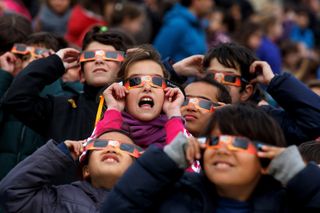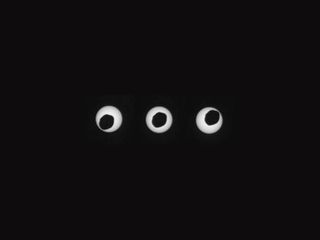1 Day Until the Solar Eclipse! NASA Scientist Explains What Makes Eclipses Spectacular
We're just one day away from the Great American Solar Eclipse, and people across the U.S. are flocking to the path of totality to watch the moon turn day into night as it transits the sun. It's time to pack your eclipse glasses, build your pinhole projectors, and check the traffic and weather forecasts as you make your final preparations for this once-in-a-lifetime astronomical event.
You can also visit Space.com for a live solar eclipse webcast, courtesy of NASA, beginning at 12 p.m. EDT (1600 GMT).
Total solar eclipses aren't as rare as they may seem, but the chances that you'll encounter more than one in your lifetime are slim. They actually happen somewhere on Earth about once every 18 months, but they only happen at the same location about once every 360 years. So if you happen to live somewhere in the path of totality, consider yourself lucky!

But total solar eclipses aren't just rare to specific locations on Earth; they're also pretty rare in the universe in general. Space.com spoke with astrophysicist Nicholeen Viall of NASA's Goddard Space Flight Center in Maryland about what makes solar eclipses on Earth so special. [A Brief History of Solar Eclipses, from 1900 to 2017 (Gallery)]
"This is a very particular alignment," Viall said, "because the moon, of course, is not the same size as the sun." Rather, its apparent size when viewed from Earth can be the same as the apparent size of the sun in the sky. Because the moon's orbit around Earth is shaped like an ellipse, its apparent size also changes along with its distance from Earth. To block out the sun's light, the moon must be both at the right distance and in the right position in the sky at the same time.
"To get that geometry to line up, that's kind of a special thing," Viall said. While it would be possible to have solar eclipses on other planets, the likelihood that another planet in our solar system would have a moon of the perfect size, shape and orbit to produce a total solar eclipse is small, she said. On the other hand, annular solar eclipses — in which a moon passes before the sun but isn't large enough to block the entire solar disk — have been spotted from other planets. NASA's Mars rover Curiosity has seen at least one eclipse like this as the Martian moon Phobos transited the sun.

Total solar eclipses won't be visible from Earth in the very distant future, Viall said.
Get the Space.com Newsletter
Breaking space news, the latest updates on rocket launches, skywatching events and more!
"Here on Earth, there is going to be a day when we're not going to have [total] solar eclipses anymore, because as the moon gets further and further away from the Earth, there will be a day when it won't block out the sun anymore," she said. Scientists have estimated that the last total solar eclipse on Earth will happen about 600 million years from now. "That will be a sad day," Viall said.
But no one living on Earth today will see the day that the moon ventures too far from Earth to produce a total solar eclipse. And once that happens, there will still be annular, or "ring," eclipses instead. Still, anyone in the U.S., whether you're in the line of totality or will have a partial solar eclipse, should make an effort to see Monday's eclipse — you may not get another chance to see one in your lifetime.
Editor's note: Find out how the solar eclipse will look from your location — Space.com has teamed up with Simulation Curriculum to offer this awesome Eclipse Safari app to help you enjoy your eclipse experience. The free app is available for Apple and Android, and you can view it on the web. If you take an amazing photo of the Aug. 21 solar eclipse, let us know! Send photos and comments to spacephotos@space.com and share your eclipse experience with us at eclipse2017@space.com.
Email Hanneke Weitering at hweitering@space.com or follow her @hannekescience. Follow us @Spacedotcom, Facebookand Google+. Original article on Space.com.
Join our Space Forums to keep talking space on the latest missions, night sky and more! And if you have a news tip, correction or comment, let us know at: community@space.com.

Hanneke Weitering is a multimedia journalist in the Pacific Northwest reporting on the future of aviation at FutureFlight.aero and Aviation International News and was previously the Editor for Spaceflight and Astronomy news here at Space.com. As an editor with over 10 years of experience in science journalism she has previously written for Scholastic Classroom Magazines, MedPage Today and The Joint Institute for Computational Sciences at Oak Ridge National Laboratory. After studying physics at the University of Tennessee in her hometown of Knoxville, she earned her graduate degree in Science, Health and Environmental Reporting (SHERP) from New York University. Hanneke joined the Space.com team in 2016 as a staff writer and producer, covering topics including spaceflight and astronomy. She currently lives in Seattle, home of the Space Needle, with her cat and two snakes. In her spare time, Hanneke enjoys exploring the Rocky Mountains, basking in nature and looking for dark skies to gaze at the cosmos.
